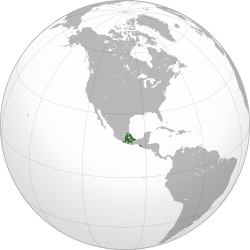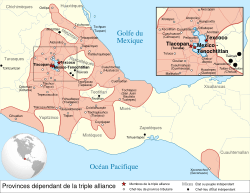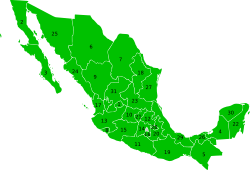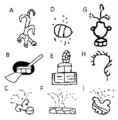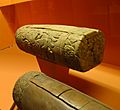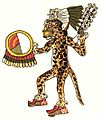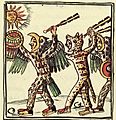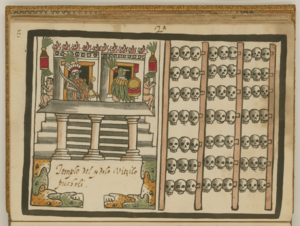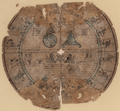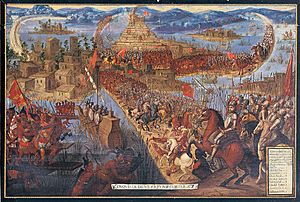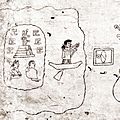Aztec Empire facts for kids
The Aztec Empire was a very large and powerful empire in Central America. It existed from about 1345 AD to 1521 AD. At its biggest, the empire covered most of Mesoamerica, which is a historical region in North and Central America.
The Aztecs built one of the most advanced societies in the world during this time. Their warriors were very strong. They took over many nearby states. This helped spread Aztec culture and religion across Mesoamerica.
However, in 1519, Spanish explorers called conquistadors arrived. With help from the Aztecs' enemies, the Spanish fought for control. On August 13, 1521, the Aztec Empire fell. The Spanish took over and made the area a colony. They renamed it New Spain.
Contents
History of the Aztec Empire
Before the Aztec Empire, many separate city-states existed in central Mesoamerica. These were small cities with farmland around them. Each had its own ruler. Around 1100 AD, these city-states began fighting for power and land.
By about 1400, two city-states had grown into small empires. In 1428, these two empires fought the Tepanec War. The Texcoco empire made an alliance with other strong city-states, including Tenochtitlan. They won the war. These allies were supposed to share power equally. But by 1430, Tenochtitlan became the most powerful. It became the capital city of the Aztec Empire. Its ruler became the 'high king' of the whole empire.
How the Aztec Empire Grew
From 1430 onwards, the Aztec Empire grew bigger. Its military took over most of what is now northern Mexico. At its peak, the Aztec Empire controlled 135,000 square kilometres (almost 84,000 square miles) of Mesoamerica.
When the Aztecs took over a state, they often took prisoners for ritual human sacrifice in Tenochtitlan. The conquered state also had to pay the Aztec Empire "tributes." These were like taxes. As the Aztecs took over more states, these tributes made them very rich.
Sometimes, the Aztecs brought a conquered state and its people into the empire. But if a state was on the edge of the empire, the Aztecs might let it stay separate. This created a buffer zone, protecting them from invasion by other powerful states.
Tenochtitlan: The Capital City
The Aztecs built their capital city right on Lake Texcoco. As the empire grew, so did Tenochtitlan. By the early 1500s, at least 200,000 people lived there. This made Tenochtitlan the largest city in the Americas before Christopher Columbus arrived.
Tenochtitlan was the center of the Aztec government and religion. It was also a very big trading center. When the Spanish arrived in 1519, they thought 60,000 people came to the market every day. People bought and sold many things, including slaves (who were often prisoners of war). The city had a huge pyramid called the Templo Mayor (Great Temple). The whole city was decorated with art, architecture, and stone sculptures.
The Aztecs created canals all across the city. These canals brought water to Aztec crops, helping them grow much more food. The Aztecs also built levees to protect the city from flooding. They also had reservoirs for fresh water.
-
"Water tunnel" coming from the Aztec Great Temple
Aztec Society and Daily Life
At its strongest, the Aztec Empire controlled about 11,000,000 people. These people belonged to different social classes. The most important people were the rulers. Next were nobles. These included powerful government members, great warriors, judges, and priests. They had a high social status.
The next social class was the commoners, or everyday workers. Most of them farmed, ran stores, or traded. Commoners could own land as a group or family. However, a single person could not own land.
The lowest social classes were serfs and then slaves. Slaves had no rights. But if they had money, they could buy their freedom and become commoners. For most of the Aztec Empire's history, it was very hard to move between social classes. People usually stayed in the class they were born into.
Education for All
By age 15, all children in the Aztec Empire had to go to school. This was true no matter what social class they were in. This was very unusual for the time. In other places, like Europe, only boys went to school, and only rich people could afford it.
Until age 15, parents taught their children at home. After that, all children went to school. For most boys, the main goal of school was to train them to be the best possible warriors for the Empire.
Children of commoners went to schools called telpochcalli ('youth houses'). Boys received military training. Girls learned how to do religious ceremonies. Both boys and girls learned about Aztec religion, morals, and history. They also learned singing, dancing, and public speaking.
Children of nobles went to a school called a calmecac. This school prepared them for leadership jobs in the Empire. These jobs included military or government leaders, priests, scholars, teachers, and healers. These schools taught subjects like astronomy, geometry, mathematics, debate, law, music, poetry, architecture, agriculture, and war. Boys had to live at their schools. They usually started at age 15 and left around age 20 to get married. Girls could become priestesses or work in medicine, like helping other women give birth.
Aztec Rules and Morals
The Aztecs had strict rules and punishments for people who broke their morals. For example, causing trouble in public or drunkenness could be punished very severely.
-
Aztec 'high lords' from the top social class
-
Merchants, who were commoners, carrying goods to sell
-
An example of the Aztec language written using the European alphabet
-
Drums were important in Aztec society. These two Aztec drums are now in a museum
The Powerful Aztec Military
All adult men in the Empire had to be part of the Aztec military. Men from states allied with the Aztecs also fought. Some men from conquered states also joined. Because of this, the Aztec military was very large and powerful.
At this time, most battles happened in big cities. If an army took over one of a state's biggest cities, it could then control all the land around those cities.
Aztec warriors protected themselves with thick cotton armour. They also had shields made of wood or reeds, covered in dried animal skins.
For weapons, warriors had a few choices:
- Macuahuitl: A very sharp sword with a point made of obsidian. Obsidian can be sharpened like glass. This sword could also be used as a club.
- Atlatl: A weapon used to throw spears or darts.
- Bows and arrows.
Aztec Religion and Gods
The Aztecs were pantheistic. This means they believed in many different gods. Two of the most important gods they worshipped were Huitzilopochtli, the god of war and the sun, and Tlaloc, the rain god. The Aztecs built temples for these gods at the top of the pyramid in Tenochtitlan. They also worshipped hundreds of other gods. Each god controlled a part of human life (like Quetzalcoatl, the god of learning and civilization) or a part of nature (like Zipe Totec, the god of springtime and regrowth).
The sun was very important in the Aztecs' religion. They believed the world went through five stages, and each had its own sun. At the end of each stage, the gods would destroy the world and create a new one. They thought they were living in the fifth and last stage. They believed the gods could decide to destroy the world at any moment.
Keeping the Gods Happy
The Aztecs did many things to honor their gods and keep them happy. For example, they held festivals, had banquets, made statues, and buried valuable items as offerings. They also did penance, like cutting themselves to let blood out. This was to ask the gods for forgiveness. They also performed ritual sacrifice of animals as part of religious rituals.
Aztec Culture and Art
Some historians say the Aztecs had a "culture of war." This means that everything focused on making people into good warriors. Boys were taught from a young age to be warriors. Girls were prepared for the "battle" of childbirth. Women who died while giving birth were seen as goddesses. They were believed to travel with the sun across the sky each day.
However, Aztec culture had many other parts. They studied astrology and used the movements of the planets and stars to create different calendars. They understood and taught things like mathematics and poetry. They had a complex view of religion, the universe, and many other things.
Art and Architecture
Aztec culture valued and appreciated art. They collected art from all over their Empire to decorate Tenochtitlan. They also formed guilds of artisans. These were people who specialized in making certain kinds of art. They made paintings, pottery, carvings, and many other things. They used materials like gold, silver, amethyst, wood, and stone. Huge stone sculptures were a popular type of art. Aztec artists also made their pyramids and other stone buildings into art by carving into them.
The Aztecs used symbolism in their art. They even used art as propaganda. For example, when they took over a state, they built temples and statues with Aztec symbols. They also used paintings that showed Aztec rulers as being close to the gods. This art spread Aztec religion and culture. It also reminded conquered states how powerful the Aztec Empire was.
-
An engraving that represented the four circles of life
The End of the Aztec Empire
From 1519 to 1521, Spanish conquistadors, led by Hernán Cortés, defeated the Aztec Empire. They turned the Empire into a Spanish colony called New Spain.
At first, things between the Spanish and the Aztecs were friendly. However, while Cortés was away, Spanish soldiers attacked and killed many Aztecs during a festival. The Aztecs fought back and killed many Spanish soldiers. The conquistadors then left Tenochtitlan.
Ten months later, Cortés returned to Tenochtitlan with more soldiers. They started a siege of Tenochtitlan. This meant no food or supplies could get into the city. After 91 days, with no food and disease spreading, the new emperor Cuauhtemoc finally surrendered to the Spanish on August 13, 1521. The Spanish destroyed Tenochtitlan. The Aztec Empire had ended.
Images for kids
-
First page of the Codex Boturini, showing the migration of the Mexica.
-
Jaguar warriors in a flowery war from the Codex Zouche-Nuttall
-
Codex Azcatitlan depicting the Spanish army, with Cortés and Malinche in front
See also
 In Spanish: Imperio azteca para niños
In Spanish: Imperio azteca para niños


